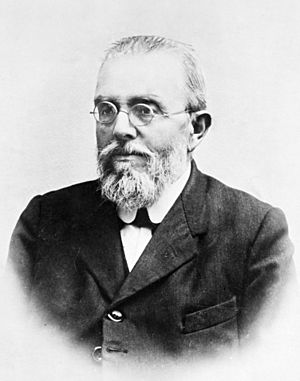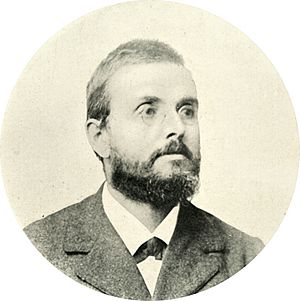Giovanni Battista Grassi facts for kids
Quick facts for kids
Giovanni Battista Grassi
|
|
|---|---|
 |
|
| Born | 27 March 1854 Rovellasca, Italy
|
| Died | 4 May 1925 (aged 71) Rome, Italy
|
| Resting place | Fiumicino |
| Nationality | Italian |
| Alma mater | University of Pavia |
| Known for | Plasmodium life cycle Malaria control |
| Awards | Darwin Medal |
| Scientific career | |
| Fields | Medicine, Entomology, Parasitology |
| Institutions | University of Catania Sapienza University of Rome |
| Doctoral students | Gustavo Pittaluga Fattorini |
Giovanni Battista Grassi (born March 27, 1854 – died May 4, 1925) was an Italian doctor and zoologist. He is best known for his important work on parasitology, especially on malaria. He taught at the University of Catania starting in 1883. Later, from 1895 until his death, he was a professor at Sapienza University of Rome.
Grassi made many scientific discoveries. He studied how honey bees develop, different types of parasitic worms, and a bug called phylloxera that harms grapevines. He also researched how eels migrate and change, and how termites live. Grassi was the first to fully describe the life cycle of the human malaria parasite, Plasmodium falciparum. He also found out that only female Anopheles mosquitoes can spread the disease.
His work on malaria caused a big argument in the history of the Nobel Prizes. A British army surgeon, Ronald Ross, won the 1902 Nobel Prize in Physiology or Medicine for finding out how malaria parasites spread in birds. However, Grassi, who showed the complete way human malaria spreads and correctly identified the types of malaria parasites and the mosquito that carries them, was not given the prize.
Grassi was also the first to show the life cycle of the human dwarf tapeworm, Taenia nana. He proved that this tapeworm does not need another animal to live in during its life cycle, which was a new idea at the time. He also showed how the roundworm Ascaris lumbricoides spreads directly, even experimenting on himself! He described a type of filarial worm found in dogs, Dipetalonema reconditum, and showed how it completes its life cycle in fleas. He also created the group of worms called Strongyloides. In 1885, he named a spider Koenenia mirabilis after his wife, Maria Koenen. He also helped start the idea of pest control for the phylloxera bug that attacks grapevines.
Contents
Biography
Grassi was born in Rovellasca, Italy, in an area now called the Province of Como. His father, Luigi Grassi, worked for the town, and his mother, Costanza Mazzuchelli, was known for being very smart. He went to school in Saronno when he was young.
From 1872, he studied medicine at the University of Pavia. He learned from famous professors like Camillo Golgi and Giulio Bizzozero. He finished his studies in 1878. After graduating, he worked at the Naples Zoological Station in Messina. There, he studied small sea creatures called Chaetognatha. He then continued his training in Germany at the University of Heidelberg. While in Heidelberg, he married Maria Koenen.
In 1883, Grassi became a professor at the University of Catania. He studied tapeworms and the life cycle of the European eel. In Catania, he also started studying insects and wrote a book for students called "The Origin and Descent of Myriapods and Insects". He also began to study malaria, working with Raimondo Feletti on malaria that affects birds.
In 1895, he became a professor at Sapienza University of Rome. He stayed there for the rest of his life. He joined other scientists like Angelo Celli and Amico Bignami who were also studying malaria around Rome. Grassi was the expert on insects in their group. On December 4, 1889, the group announced an important discovery. They showed that a healthy man, who was in an area without malaria, got sick with malaria after being bitten by an Anopheles claviger mosquito that had been infected on purpose. Between 1900 and 1902, Grassi and his colleagues studied malaria very closely in different parts of Italy.
In 1902, Grassi stopped studying malaria for a while. He started working on the sandfly that causes Leishmaniasis and on the harmful insect that attacks grapevines, Phylloxera vastatrix. When malaria became a big problem again in Italy during and after the First World War, Grassi went back to studying mosquitoes.
He passed away in Rome in 1925 while he was reading the final version of his last scientific paper, Lezione sulla malaria.
Grassi wanted to be buried in a village cemetery in Fiumicino, near Rome. This was because he did some of his most important medical research there. His wife Maria and daughter Isabella are also buried in the same tomb.
Professional achievements
Anatomy and entomology
Grassi's early work was about anatomy (the study of body structure) and then entomology (the study of insects). He studied how the backbone develops in bony fishes and also a health problem called goiter. His studies on bees, myriapods (like centipedes), and termites were very important. He also studied small sea creatures called chetognates and how eels reproduce. In 1885, he described a new type of spider, Koenenia mirabilis, which he named after his wife.
He also made big contributions to understanding the phylloxera bug that harms grapevines. He studied this bug for several years. His notes, called La questione fillosserica in Italia (1904), helped the Italian Ministry of Agriculture. They asked him to do a full study on the topic. In 1912, he wrote a huge report about the shape and life of phylloxera bugs in Italy and other parts of Europe. This work became a key part of how to control farm pests.
Helminthology
In 1876, Grassi investigated why many cats were dying in his hometown of Rovellasca. He found that they were heavily infected with a nematode worm called Dochmius balsami. In 1878, while still a student, he discovered a worm infection called anchylostomiasis in Italy. He continued to make big discoveries about other worms, including Anguillula intestinalis, filarial worms, Trichocephalus dispar, and Bilharzia.
He was the first to show that the human dwarf tapeworm Taenia nana can complete its whole life cycle inside one animal. Before this, people thought it needed another animal to live in. He also showed that the flea Pulex serraticeps is where the cat tapeworm Taenia elliptica lives for part of its life. Because of this, he suggested that children might get tapeworms by accidentally swallowing infected fleas, for example, with milk. In 1879, he published work on the life cycle of Strongyloides stercoralis and created the group of worms called Strongyloides. In 1890, he and Salvatore Calandruccio described Dipetalonema reconditum, a harmless filarial worm found in dogs. They showed that this parasite finishes its development inside human fleas, Pulex irritans.
Grassi took a brave step to understand the life cycle of the roundworm Ascaris lumbricoides. To solve the mystery of how this worm spreads, he ate roundworm eggs himself on August 30, 1879. Twenty-two days later, he found fresh eggs in his own waste. This proved that roundworms spread directly when someone eats something contaminated with the eggs.
Malaria and the life cycle of Plasmodium
Grassi first contributed to malaria research in 1890. He and Raimondo Feletti discovered Haemamoeba vivax, which was later renamed Plasmodium vivax. He also described Proteosoma praecox, which is the malaria parasite found in birds. In 1891, he was the first to inject malaria parasites from one bird into another. He also wrote the first complete book about the different types of malaria parasites and what they do. His book Studi di uno Zoologo Sulla Malaria (1891) is still important today.
His descriptions of the specific features of different types of malaria helped clear up confusion. He explained benign tertian (Haemamoeba vivax), malignant tertian (Laverania malariae, now P. falciparum), and quartan (Haemamoeba malariae, now P. malariae) malaria. His book also showed clearly for the first time that only bites from female Anopheles mosquitoes could spread malaria. In a famous experiment, he sent 112 volunteers to a malaria-prone area. They were protected from mosquito bites between sunset and sunrise. Only five of them got malaria, compared to 415 unprotected volunteers who all got sick. In 1898, Grassi and Bignami finally proved that mosquitoes spread malaria. They fed local mosquitoes (A. claviger) on infected patients. Then, they found that people who had not been infected before got malaria after being bitten by these mosquitoes.
Recognition
Grassi received the Royal Society's Darwin Medal in 1896 for his work on termites.
The King of Italy, Victor Emmanuel III, made him a senator.
In 1955, the Italian post office issued a stamp with Grassi's picture on it to honor him.
His birthplace in Rovellasca is now a community center for older people. On the front wall, there is a statue of his head and an inscription that says:
IN QUESTA CASA DEI SUOI AVI
NACQUE IL 27 MARZO 1854
BATTISTA GRASSI
MEDICO E MAESTRO SCIENZIATO E FILOSOFO
CONTESE ALLA BIOLOGIA I SUOI SEGRETI
NE TRASSE ARMI CONTRO LA FEBBRE PALUSTRE
INVANO COMBATTUTA DA SECOLI
MORTO A ROMA IL 4 MAGGIO 1925
VOLLE ESSERE SEPOLTO A FIUMICINO
FRA GLI UMILI LAVORATORI
DELLA MAREMMA E DELLA PALUDE
DI CUI AVEVA INIZIATO LA REDENZIONE
I SUOI CONCITTADINI DEDICANO
LAPIDE RINNOVATA E ONORATA
NEL I° CENTENARIO DELLA NASCITA
MENTRE NEL MONDO SI AVVERA
IL SUO SOGNO D'UMANA REDENZIONE
DAL SECOLARE FLAGELLO MALARICO
27 MARZO 1954
This means: IN THIS HOME OF HIS ANCESTORS / ON MARCH 27, 1854, BATTISTA GRASSI WAS BORN / A DOCTOR AND GREAT SCIENTIST AND THINKER / HE FOUGHT TO UNCOVER BIOLOGY'S SECRETS / HE FOUND WAYS TO FIGHT MARSH FEVER (MALARIA) / WHICH HAD BEEN FOUGHT UNSUCCESSFULLY FOR CENTURIES / HE DIED IN ROME ON MAY 4, 1925 / HE WANTED TO BE BURIED IN FIUMICINO / AMONG THE HUMBLE WORKERS / OF THE MARSHY LAND / WHOSE FREEDOM HE HAD BEGUN / HIS FELLOW CITIZENS DEDICATE / THIS RENEWED AND HONORED STONE / ON THE 100TH ANNIVERSARY OF HIS BIRTH / WHILE HIS DREAM OF HUMAN FREEDOM / FROM THE ANCIENT SCOURGE OF MALARIA / COMES TRUE IN THE WORLD / MARCH 27, 1954.
See also
 In Spanish: Giovanni Battista Grassi para niños
In Spanish: Giovanni Battista Grassi para niños


